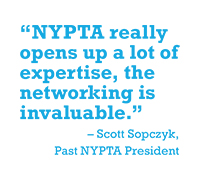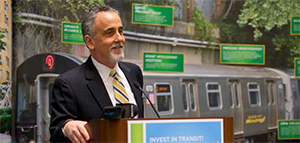An Evolution: Rolling Into Tomorrow
NYPTA Celebrates 30 Years

Who would have thought, in 1983, of the idea of a statewide organization serving more than 130 local public transportation providers, plus hundreds of private sector manufacturers, vendors, consultants, government agencies and millions of bus and subway riders; pumping millions of dollars into the state economy each year; stimulating job growth and improving the environment?
Actually, the birth of the New York Public Transit Association was less a grandiose idea acted upon than it was the evolution of responses to the collective agendas, issues and needs of the smaller, mostly rural, upstate transit operators. “The problem was upstate public transit authorities were mostly small and operating independently,” said Joseph H. (Joe) Boardman, at that time the Broome County Commissioner of Public Transportation, “and without a common organization.”
 Boardman, Carm Arcuri of the Utica Public Transit Authority, Herb Heckler of Ulster County Rural Transportation, John Insetta, the Director of Transportation for the City of Oneonta, Ithaca City Transit Manager Bernie Carpenter and Tom Freeman of Chemung County Transit were kindred spirits. They provided a valuable service to their communities but lacked the financial wherewithal of their larger city counterparts. They had no defined avenue for brainstorming, sharing best practices or learning about new methods and procedures. But they did have one advantage.
Boardman, Carm Arcuri of the Utica Public Transit Authority, Herb Heckler of Ulster County Rural Transportation, John Insetta, the Director of Transportation for the City of Oneonta, Ithaca City Transit Manager Bernie Carpenter and Tom Freeman of Chemung County Transit were kindred spirits. They provided a valuable service to their communities but lacked the financial wherewithal of their larger city counterparts. They had no defined avenue for brainstorming, sharing best practices or learning about new methods and procedures. But they did have one advantage.
Some professional trade associations have adversarial relationships with their governmental counterparts, but the upstate transit operators found a very collaborative partnership with the New York State Department of Transportation. Bill Acquario was the go-to guy at NYSDOT for transit industry information. He coordinated two annual statewide transit conferences, shared information and supported the educational goals of the upstate operators. “New York operators wouldn’t necessarily attend the national conference,” Acquario recalled, “but they did attend DOT’s annual conference. It was the impetus for NYPTA.”
The relationship with NYSDOT was beneficial to both sides. Acquario called it “… a very significant event. It (NYPTA) gave credibility to DOT that it could provide for the upstate transit systems. It’s a crucial organization.”
There were other benchmarks along the way. David Gunn of the MTA and New York City Transit began a dialogue with the upstate systems. “The big breakthrough was when David Gunn of the MTA got involved,” said Boardman. “He could see the small upstate systems represented a large part of the state’s political structure…and the value in working together.” Soon, the Albany, Buffalo, Rochester and Syracuse transit systems were part of the group. “There was some trepidation,” admitted past NYPTA President and former Executive Director of the Capital District Transportation Authority Dennis Fitzgerald, “but the MTA’s involvement was a big factor. We decided to go with the NYPTA model.” Westchester and Suffolk Counties were then recruited and, finally, the MTA officially came on board.
Another significant event was the formation of a powerful coalition of industry manufacturers and suppliers. Led by Gordon Nevison (The Nevison Group), Ed Gallagher (American Seating Company) and Bruce Black (Detroit Diesel Corporation), the coalition became a conduit of information and goodwill among NYPTA members and a tireless supporter of NYPTA’s mission, vision, values and programs.
By the early nineties, NYPTA had established a headquarters in Albany and, under President Karen Rae, enlisted the assistance of professional advocacy and managerial service providers. Its lobbying efforts became more effective, its communications more strategic, and its educational programs more timely and relevant to its members. It had a plan and a determination to grow the transit industry in New York, and was on its way!
The Message
 The first critical success for NYPTA was raising the awareness of the funding necessary for operations and capital and how to finance public transportation at that time. From there it would grow into a statewide voice for public transportation on several levels, beginning locally. It was, and remains, a message that public transit must be viable for communities to be strong. Consider: Public transit takes people to work; it is essential to people on budgets and unable to afford cars. It is a critical resource for people with disabilities and unable to drive. On a daily basis, New Yorkers make more than 9 million trips to work, school, shopping and health care.
The first critical success for NYPTA was raising the awareness of the funding necessary for operations and capital and how to finance public transportation at that time. From there it would grow into a statewide voice for public transportation on several levels, beginning locally. It was, and remains, a message that public transit must be viable for communities to be strong. Consider: Public transit takes people to work; it is essential to people on budgets and unable to afford cars. It is a critical resource for people with disabilities and unable to drive. On a daily basis, New Yorkers make more than 9 million trips to work, school, shopping and health care.
One of the most visible aspects of the NYPTA message is its contribution to the state economy where, as the MTA’s Hilary Ring points out, “NYPTA helps highlight the economic development aspect of the Transit Industry.” Public Transit Authorities employ more than 75,000 people across the state. They do daily business with hundreds of manufacturers, vendors and service providers throughout New York, and indirectly create thousands of more jobs through them. The buses, rail cars and engines that are made in New York are purchased here by NYPTA-member transit authorities. So, the capital invested in public transit says in the state, and is multiplied many times through the salaries and wages of thousands of employees and the purchases of services and supplies from hundreds of small businesses. Businesses and jobs thrive because of the public transportation infrastructure, producing tax revenue for the State.
 Public Transit also lessens the dependence upon foreign oil, which has ecological and environmental, as well as political benefits. It reduces our carbon footprint and lessens dependence on foreign oil by keeping cars parked. Former NYPTA President Rick Swist quantified it: “Think about it. If you’re driving down the road and it’s crowded, how much worse would it be if just one of those buses wasn’t there? There could be as many as 40 more cars on the road during your commute.”
Public Transit also lessens the dependence upon foreign oil, which has ecological and environmental, as well as political benefits. It reduces our carbon footprint and lessens dependence on foreign oil by keeping cars parked. Former NYPTA President Rick Swist quantified it: “Think about it. If you’re driving down the road and it’s crowded, how much worse would it be if just one of those buses wasn’t there? There could be as many as 40 more cars on the road during your commute.”
Today the NYPTA message is one coming from a strong, critically important organization bridging the public and private sectors. NYPTA Keeps New York Moving toward a stronger economy, a cleaner environment, greater collaboration among stakeholders, and a more mobile society.
The Partnerships
 One of the most vital pieces of NYPTA’s growth and success over the years is the relationships it has formed. Beginning with the alliance with the New York State Department of Transportation and continuing through partnerships with transit industry manufacturers, service providers and vendors, lawmakers, labor, riders, the disability community and environmental interests, NYPTA managed to unite these connected, but largely disparate groups, for the benefit of all.
One of the most vital pieces of NYPTA’s growth and success over the years is the relationships it has formed. Beginning with the alliance with the New York State Department of Transportation and continuing through partnerships with transit industry manufacturers, service providers and vendors, lawmakers, labor, riders, the disability community and environmental interests, NYPTA managed to unite these connected, but largely disparate groups, for the benefit of all.
The key has been getting everyone pulling in the same direction. Hilary Ring cites one example as an offshoot of NYPTA advocacy at the state capital, where the organization was able to bring together lawmakers and the NYPTA suppliers and business partners from their districts. “Contacts with vendors are very important to the Legislature,” Ring said, “and those contacts would not have been made without NYPTA.” Those contacts are also important to the transit systems, especially the smaller ones. Scott Sopczyk, also a past NYPTA President and the Transportation Director of Greater Glens Falls Regional Transit, says operators of smaller systems like his would only talk to manufacturers and vendors by phone or email. “NYPTA made face to face meetings possible,” he said, “and that’s extremely beneficial.”
 For Sopczyk, the best partnerships he has formed are the ones within NYPTA itself. With so much variability from one area to another, there is no one-size-fits-all approach to public transit. Exchanging ideas, best practices and options is critical. “NYPTA really opens up a lot of expertise,” Sopczyk says, “The networking is invaluable.”
For Sopczyk, the best partnerships he has formed are the ones within NYPTA itself. With so much variability from one area to another, there is no one-size-fits-all approach to public transit. Exchanging ideas, best practices and options is critical. “NYPTA really opens up a lot of expertise,” Sopczyk says, “The networking is invaluable.”
The relationship that paved the way for all the rest is the one NYPTA has established with the upper levels of state government. “We had a dialogue with our local legislators,” Dennis Fitzgerald remembered, “but NYPTA helped us talk outside our district, to committee chairs. The Department of Budget became more forthcoming than it had been previously. NYPTA gave us a heckuva lot more information.”
The People
 The growth of any organization is a function of the vision, dedication, intelligence and work ethic of its people. The story of NYPTA is replete with professionals who devoted their lives to the transportation industry and the people it served. Some have gone on to serve in transportation leadership positions at the state and federal levels of government. Founding member and past NYPTA President Joe Boardman spent eight years as Commissioner of the New York State Department of Transportation. In 2005, President George W. Bush nominated him to lead the Federal Railroad Administration and in 2008 Boardman became the President and CEO of Amtrak.
The growth of any organization is a function of the vision, dedication, intelligence and work ethic of its people. The story of NYPTA is replete with professionals who devoted their lives to the transportation industry and the people it served. Some have gone on to serve in transportation leadership positions at the state and federal levels of government. Founding member and past NYPTA President Joe Boardman spent eight years as Commissioner of the New York State Department of Transportation. In 2005, President George W. Bush nominated him to lead the Federal Railroad Administration and in 2008 Boardman became the President and CEO of Amtrak.
Karen Rae’s career followed a somewhat similar path. She managed transit systems in Glens Falls and Buffalo, served as NYPTA President (1992-1993), was named Deputy Secretary for Local and Area Transportation in the Pennsylvania Department of Transportation and served as Deputy Commissioner of Policy and Planning at NYSDOT. In March of 2009 the Obama administration named her Deputy Administrator of the Federal Railroad Administration. In 2011, she was recognized as Woman of the Year by the Women in Transportation Seminar. Later that year, Rae returned to New York as Deputy Secretary of Transportation in the office of Governor Andrew Cuomo.
Another notable story is that of the late Peter Cassels. Starting as a janitor with the Third Avenue Railroad/Surface Transit in New York City, he used a solid work ethic and innate leadership ability to rise through the ranks as mechanic, foreman, assistant supervisor and supervisor. By the time he retired 31 years later, Cassels was general superintendent of surface transit. He was a man of influence, and left his mark on his transit colleagues, his NYPTA colleagues and the transit industry.
There are many more who proudly served NYPTA; some in the Hall of Fame, others destined to get there. Joe Boardman’s reflection on the early days really speaks to the entire 30 years: “We had good people.”
On the Horizon

The New York Public Transit Association is a forceful champion of public transportation. “We’re stronger than we’ve ever been,” says Frank Kobliski, Executive Director of Centro and a past two term NYPTA president, “everybody’s in, from Long Island to Niagara Falls.” Kobliski says the 2013 Transit Advocacy Day at the State Capital was proof. “They heard us better than they’ve ever heard us. People paid attention.”
 NYPTA has built an impressive track record. It has won battles for public policy and safety. It is the voice of the message for moving the industry…and the State…forward. It offers a diverse menu of services and support to its members and is ready to lead the way to cleaner air, more convenient commuting and safer roadways for all New York communities, large and small. With changing demographics, and more young people moving into urban areas, Hilary Ring believes “As public transportation becomes even more important to people, NYPTA becomes more central to the discussion.” Current President Carm Basile says it’s well positioned: “We have an engaged membership of people who are passionate about what they do. We have a great relationship with (NYS) DOT and a cause that resonates with the public. We’re in great shape to see that New Yorkers keep getting the kind of public transit improvements they deserve.”
NYPTA has built an impressive track record. It has won battles for public policy and safety. It is the voice of the message for moving the industry…and the State…forward. It offers a diverse menu of services and support to its members and is ready to lead the way to cleaner air, more convenient commuting and safer roadways for all New York communities, large and small. With changing demographics, and more young people moving into urban areas, Hilary Ring believes “As public transportation becomes even more important to people, NYPTA becomes more central to the discussion.” Current President Carm Basile says it’s well positioned: “We have an engaged membership of people who are passionate about what they do. We have a great relationship with (NYS) DOT and a cause that resonates with the public. We’re in great shape to see that New Yorkers keep getting the kind of public transit improvements they deserve.”
Click on the image to view or download the complete article.


